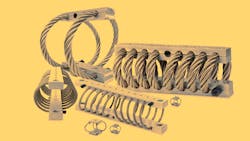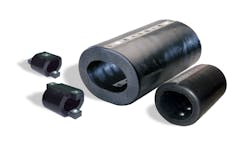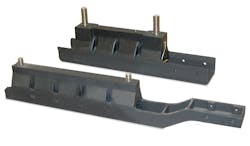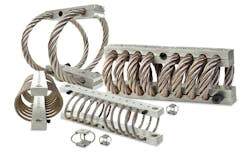Vibration Isolation: One Purpose, Infinite Applications
At a Glance:
- Prolonged or excessive vibration can interfere with performance and damage equipment.
- Wire rope isolators can reduce noise, vibration and shock levels all at once, which gives them a very favorable cost-to-value ratio.
- ITT Enidine offers a personalized, multi-phase testing process to determine how different shock and vibration isolation solutions would perform in the field.
Harmful shock and vibration can come from almost anywhere to inflict harm and create vulnerabilities. The aerospace and defense industries are no stranger to high-stakes, mission-critical situations and need to have equipment and machinery they trust to stay safe. Since the end of the Second World War 75 years ago, these industries have innovated to create thousands of specialized vehicles designed for air, land and sea. Their capabilities and missions are expansive, running the gamut from cargo transport to hurricane hunting, and yet they all have one thing in common: vulnerability to vibration.
As all engineers know, mechanical motion at high operating speeds can have harmful side effects. Prolonged or excessive vibration can interfere with performance and damage equipment. Left unchecked, these forces can compromise crew safety and shorten the operational lifespan of vehicles and components, resulting in expensive downtime.
By themselves, these are strong motivations to embrace technologies that mitigate various types of vibration. But there is more to consider than just a smooth ride. Shock and vibration isolators also prove their worth by increasing operational safety and lowering maintenance costs over time. These isolators keep aerospace and defense vehicles safe, in turn keeping our military safe. They are the unsung heroes of the aerospace and defense industries, along with many others.
Keeping Pace with Critical Applications
The undesirable effects of vibration on machinery go way back. In fact, aviation pioneer Orville Wright stopped flying in 1918 because aircraft vibrations aggravated his old injuries, making it too uncomfortable to fly. He had to forfeit the cockpit.
In those early days, finding ways to counteract vibration fatigue was a tall order. The best that pilots could do to keep equipment stable was to bolt it to the wall. Even so, “stable” was a relative term.
We’ve come a long way since then. Today’s high-performance aircraft, ships, tanks and ground vehicles must endure extreme stress, noise and vibration. Engineers have two options to cope with these operational challenges: ruggedize the equipment or isolate the problems. And since ruggedizing equipment typically adds unwanted weight and bulk, shock absorption is the more effective route.
For many aerospace, maritime and land-based applications, wire rope isolators are the solution of choice. They reduce noise, vibration and shock levels all at once, which gives them a very favorable cost-to-value ratio. Other solutions, like elastomers, can only diminish noise and vibration.
Wire rope isolators have stainless steel cable, which provides excellent, multi-axis vibration isolation. They are corrosion resistant, which makes them stable and consistent in a variety of environments. Additionally, isolators are unaffected by oil, chemicals, abrasives, ozone and temperature extremes. They require almost zero maintenance.
Wire rope isolators come in a variety of shapes and sizes to satisfy a wide range of use cases. Compact versions are ideal for use in small spaces. Their single point mounting offers flexibility for installing units in the most practical way. Often, compact wire rope isolators are used to isolate individual system components in situations where package space and sway are an issue.
Durable by design, wire rope isolators are built to last as long as the piece of equipment they are protecting without significant compression or separation. They are often used to safeguard 810G and 901E grade equipment such as navigation systems, small pumps and motors, and electronic components. Additional uses include protecting weapon, antenna and electronic systems. Typically, that means protecting components and cabinets or racks that hold them. In some cases, an entire room that houses these types of assets must be outfitted with wire rope isolators.
Large cargo loads can also be protected. Configurations such as a deck plate isolation system that rests on an array of wire rope isolators keep payloads safe from damage during transport. This solution will likely be in greater demand as autonomous supply vehicles become commonplace.
Other critical applications include weapon energy absorption and electronic isolation. The U.S. Navy employs a combination of skid isolators and High Energy Rope Mount (HERM) isolators to protect its Helios laser weapons system. And both military and commercial air fleets rely on standard wire rope isolators to prevent damage to racks of sensitive computer hardware.
Finding the Best Fit
Both standard and compact wire rope isolators are available off-the-shelf in various sizes that comply with aerospace and defense standards and meet Defense Federal Acquisition Regulation Supplement (DFARS) requirements for specialty metals. However, for specific use cases, isolators can be fully customized to client specifications.
ITT Enidine helps customers determine the right solutions with a personalized, multi-phase testing process. The evaluation takes into account the type of vehicle and equipment needing protection, how and where vibration isolators will be mounted, and the severity of conditions the configuration will need to endure.
The first phase of the process is a computer simulation module that incorporates the equipment specifications and requirements. Virtual trials are conducted to assess how different shock and vibration isolation solutions would perform in the field. The simulation catalogs how the virtual test vehicle and equipment respond to various configurations and then, based on the data, pinpoints the best candidates for the job—a stock unit, a custom design or a combination of both.
Once the simulation is complete, the final step is to qualify the products being considered. This involves physical experiments to verify that the solutions can meet specific performance thresholds. For smaller and medium-sized equipment, a hammer test is conducted to apply a relevant amount of force and measure shock absorption. For larger equipment and more complex configurations, larger-scale testing is required. A shipboard application, for example, may require a barge test, where explosive charges are detonated underwater to simulate severe shock and vibration conditions.
At the end of the process, customers gain more than a bespoke solution for their needs. They also receive a comprehensive analysis of the performance they can expect for the service life of their equipment or fleet of vehicles.
Continuous Improvement
It is safe to say that a wire rope isolator’s work is never done. Every new generation of airplane, watercraft and land vehicle brings with it a new set of challenges, which opens the door to new design thinking.
Today’s emerging technology, such as active vibration control that actively responds to the factors that cause vibration (such as speed, load size and weight), will become tomorrow’s standards. And those standards will guide development of new, cost-effective solutions that support a wide range of applications.
The cycle of innovation never stops. As long as there are new planes, ships and vehicles to protect, energy absorption and vibration isolation products will be along for the ride.
Mark Gilson is business development manager, ITT Enidine.



